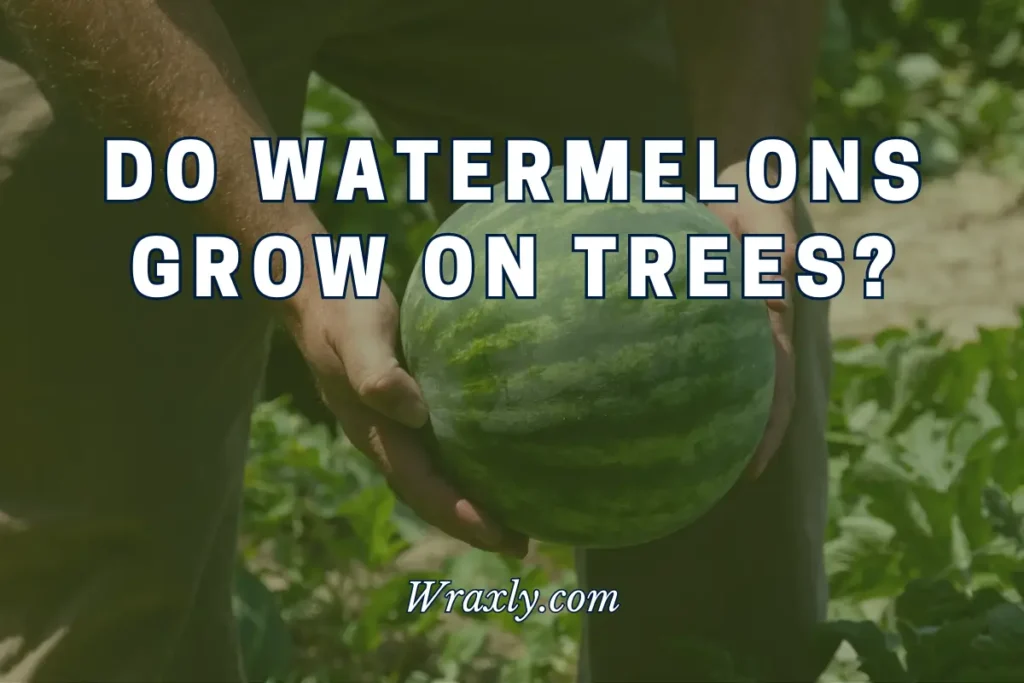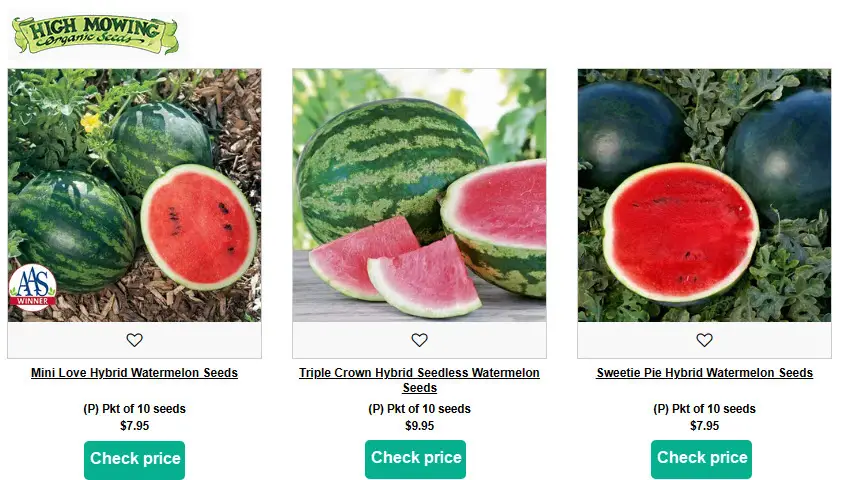The question for today is, “Do Watermelons Grow On Trees?” Before you start imagining a watermelon orchard, let’s look at the evidence. Are these juicy, sweet fruits dangling from tree branches like a fruity piñata? Is there something more to this story? Grab a slice of watermelon and join us as we unravel this juicy mystery!
In this article, we’re talking about all things watermelon cultivation! What type of soil to use, what climate is best, what productive techniques to use- we’ve got you covered! So stay tuned, and by the end of this piece, you may just start your very own watermelon garden in your backyard!

How To Grow Watermelon At Home?
You can certainly grow watermelons in your home garden too; here’s how you do it,
- Pick a spacious spot where there’s plenty of sunshine. Watermelons like to grow pretty far apart from each other, so keep that in mind.
- Prepare the soil a few weeks before planting by adding organic matter or compost to the soil.
- Plant the seeds in pots six weeks before the growing season, then transplant them into the ground you prepared. If you want to sow them directly, put 4-6 seeds by digging a wide enough hole in 70°F soil.
- Now look after the plant and care for them as needed!
Watermelon Growing Habits
Watermelons are grown in the ground. However, like their cantaloupe cousins, watermelons require 2 to 3 months of heat to develop ripe fruit, making cultivating watermelons in colder climates difficult but not impossible.
Thanks to its moderate maintenance and growing requirements, gardeners anywhere can enjoy growing watermelons in the comfort of their homes by adding plastic mulch to warm soil and floating row coverings to trap warm air near plants.
Read on to learn all the requirements to start growing your own watermelon galore!

A. Where Does Watermelon Grow?
While native to Africa, watermelons are in pretty much every continent except for Antarctica. This is because watermelon plants thrive in climates with extended, warm growing seasons. China and Turkey are major producers of this popular fruit. In the US, watermelons grow in Florida, Texas, Georgia, and California, Florida being the giant producer of them all. Why? Because they all have warm weather!
- Soil Requirements
Watermelons thrive in sandy loam soils with proper drainage and a somewhat acidic pH. Plants develop slowly in heavy soils, and fruit size and quality are typically lower. Fine sands produce the greatest quality melons when appropriate fertilizer and water are available.
- Climate Requirements
Watermelons, as you now know, are sensitive to cold temperatures, and even mild frosts can cause significant damage to the plant. During its growing season, the normal temperature ranges between 65°F and 95°F. Temperatures above 95°F and below 50°F will stunt its growth and delay development. Therefore, they need a long and hot growing season lasting anywhere from a month to 85 days!
B. How Does Watermelon Grow?
Now that we’ve delved well into the requirements of growing watermelons let’s look at how you can grow them. From planting to harvesting, you’re about to become an expert watermelon grower!
- Planting
When the soil temperature is above 65°F, you can sow watermelon seeds straight into the ground. Sow them 1/2 to 1 inch deep in groups of two or three seeds 18 to 24 inches between. After the seedlings have grown, remove two and leave the best plant in every group.
- Watering
- Watering is important from planting through fruit development. Plants require 1 to 2 inches of water every week to develop, flower and set fruit.
- Keep the soil damp but not wet. Water the vine at the base in the morning, and avoid soaking the leaves and overhead irrigation. Reduce watering once the fruit grows.
- Fertilizing
If you want to fertilize, ensure the fertilizer contains more nitrogen than phosphate and potassium, which helps with leaf and vine growth. But once blooming starts, use a fertilizer with less nitrogen for better flowers and fruit instead.
- Harvesting
A mature watermelon will be deep green in color, with a creamy golden bottom or side that touches the ground. If it is too pale, it’s not ready.
When the watermelon begins to dry out and turn brown, it is almost ripe. However, if the tendril is still green, it needs more time to grow.

How To Pick a Good Watermelon?
Choose a melon with a strong, continuous stripe pattern. Green stripes should be deep, dark green, and delicate stripes should be creamy, light yellow. You may also select a watermelon with a drab appearance. If the melon is very glossy, it is probably not ripe.
You can gently tap on the fruit and see if it’s a dull thud, which indicates it’s ready. If it’s hollow, set it down. You can also check for a yellow stem, look for dry weathering spots, and a rounder shape to get a ripe melon.
FAQ
Watermelons are slow growers. It takes 70 to 90 days to grow watermelons after sowing the seed. Watermelons can be planted from late spring through early summer when soil temperatures reach 70° F or higher. The warmer the soil, the faster it will grow. For example, it takes around three days to sprout in 90°F conditions and about ten days in 70° F. A healthy watermelon plant will produce two to four fruits each plant.
Using nitrogen-based fertilizers at the start of watermelon plants is an excellent idea. However, once the melon plants begin to flower, you should switch to a phosphorus and potassium-based fertilizer. Watermelons require a lot of potassium and phosphorus to grow well. Adding calcium to the fertilizer is also a great idea, it creates strong cell walls and membranes during development, which can really improve the quality of the melon.
If your watermelon plant is not growing well, here are a few problems that could be the cause:
-If you’re not using loose and organically rich soil to sow the melon seeds in, your plant won’t grow properly.
–CUT THOSE WEEDS OFF. They’re not as harmless as you might think; they can invade the melon roots and stunt their growth.
-Overwatering or underwatering. Watering correctly is crucial for growing watermelon, so make sure you’re watering as necessary.
-Check the plant for pests and diseases. Ignoring such issues can seriously affect the development of your watermelon plant.
For Further Reading
- When to Enjoy Fresh Rhubarb: A Guide to Rhubarb Season
- From Plant to Plate: How Many Strawberries Can You Expect?
- Pumpkin Harvest Revealed: Estimating Yield from a Single Plant
Conclusion
Watermelons grow on sprawling vines across the ground, not on trees. So if you want to grow some for yourself, consider its specific growth patterns and needs. Watermelon plants need sufficient water, sunlight, and the right amount of fertilizers to bloom into the fantastic and flavorsome fruit we so dearly enjoy on hot summer days!

Darrell has a passion for gardening that he inherited from his father. Go here to read more about the influence his father played in his love for gardening. If you want to send Darrell a quick message, then visit his contact page here.

![How to Water Indoor Plants [Plant Care 101]](https://wraxly.com/wp-content/uploads/2021/03/How-to-Water-Indoor-Plants-Plant-Care-101-1200-1024x576.webp)

![Growing Plants from Cuttings [A Simple Guide]](https://wraxly.com/wp-content/uploads/2021/03/Growing-Plants-from-Cuttings-A-Simple-Guide-1200-1024x576.webp)
